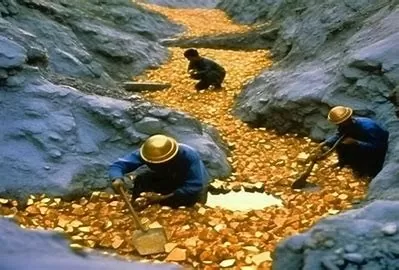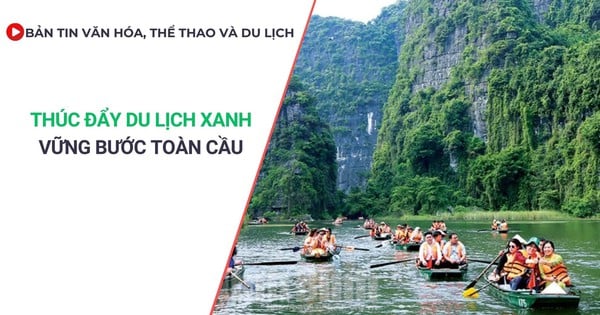Throughout the history of the world economy, gold has not been simply a precious metal. It has been the object of passion, greed and the desire for quick success. The three great gold rushes in the world in California (USA), Klondike (Canada) and Witwatersrand (South Africa) have changed the landscape of many countries. However, along with economic leaps, these countries also had to face many consequences and expensive lessons. These are experiences worth referring to for Vietnam, especially in the context that we are also promoting mineral exploitation to serve industrial development.
Three gold "rushes" in the world
California Gold Rush (1848 - 1855): Originating in the Sacramento Valley, the California Gold Rush quickly attracted hundreds of thousands of people to the new US state. According to data from History - a reputable and widely recognized information site on historical topics, by the end of 1849, California's population had increased to nearly 100,000 people, and by 1852, about $2 billion worth of gold had been mined.
However, the boom also came with serious consequences. Hydraulic mining brought huge profits but destroyed much of the region's landscape. Dams built to supply water to the mines in the summer changed the flow of rivers, affecting agriculture. Uncontrolled gold mining led to severe environmental damage and loss of land for indigenous communities. Social problems such as corruption and discrimination against gold prospectors also arose, as many groups, especially indigenous peoples and immigrants, did not benefit from the development.
 |
| The Klondike Gold Rush is credited with helping the United States pull itself out of the Great Depression. Illustration photo |
Klondike Gold Rush (1896-1899): This is one of the most notable gold rushes in history, not only because of its scale and influence but also because it opened a new chapter in the economic and social development of North America. The discovery of gold in the Klondike River, Yukon (Canada), caused a wave of mass migration. Tens of thousands of people poured into the wilderness in the hope of escaping poverty.
According to History, the Klondike Gold Rush is credited with helping the United States pull itself out of the Great Depression. However, it also had serious consequences.
According to Alaskaweb, the Canadian government failed to anticipate the sudden increase in population and did not have environmental protection policies, leading to unsustainable development of the area. In addition, gold mining devastated the ecosystem, causing soil erosion, water pollution, deforestation and biodiversity loss. Indigenous communities suffered greatly from habitat destruction and the increase in diseases such as smallpox.
The Witwatersrand Gold Rush (1886 - 1899): In June 1886, George Harrison discovered gold on Langlaagte Farm. Soon after, more than 3,000 people flocked to Johannesburg to search for gold, causing a major change in the economy. The Witwatersrand Gold Rush profoundly changed the South African economy. From a country that relied mainly on agriculture, South Africa quickly rose to become a major industrial power in Africa.
Although the South African economy is fueled by gold, the Witwatersrand gold mines have become a hotbed of political conflict, according to Goldconsul. In addition, the workforce at South African gold mines face extremely dangerous and harsh working conditions.
Gold mining has a huge environmental impact. Modern mining methods, although economically efficient, cause serious damage to nature: environmental destruction (deforestation, disruption of natural ecosystems), water pollution (poisoning by cyanide and mercury), land degradation (mining changes the terrain and causes loss of soil quality).
Lessons for Vietnam
Vietnam is currently facing a great opportunity to develop its economy from its rich mineral resources, including gold. However, the world's "gold rushes" in history have left important lessons. These lessons can help Vietnam avoid mistakes in the process of exploiting resources.
First, sustainable management of mineral resources: The gold rushes have shown that uncontrolled exploitation of natural resources can lead to serious environmental devastation. For example, hydraulic fracturing during the California gold rush caused soil erosion and altered river flows, affecting agriculture and ecology. Similarly, gold mining in the Klondike caused water pollution, soil erosion, and loss of biodiversity.
Many localities in Vietnam such as Quang Nam, Thai Nguyen, Nghe An... have witnessed illegal gold mining, causing subsidence, pollution of upstream streams and loss of control over national resources. Vietnam needs to build strict environmental protection policies and develop sustainable resource exploitation industries, especially in the face of increasing investment in mining and natural resources.
Second, there is a need to balance economic development and environmental protection: Although gold rushes like the Witwatersrand have boosted the South African economy, the benefits have not been evenly distributed, creating social injustice. Only a handful of wealthy people have benefited from the resources, while the majority of the working population remains in poverty.
Therefore, Vietnam needs to ensure that natural resources are exploited and used fairly, protecting the rights of people, especially poor and vulnerable communities. Ensuring equitable distribution of benefits from resource exploitation projects will help avoid social polarization.
Currently, Vietnam is promoting mineral exploitation to serve energy transition and industrialization (Central Highlands bauxite, Lao Cai rare earth). Integrating environmental factors into all resource development policies - from licensing to mine restoration - should be a top priority, avoiding trading the environment for short-term growth.
Third, monitor and regulate rapid development: The Klondike and Witwatersrand gold rushes both saw rapid population growth and uncontrolled development, causing infrastructure and social management problems. The Canadian and South African governments failed to anticipate and manage such rapid change, leading to long-term environmental and social problems.
Therefore, Vietnam needs to prepare infrastructure and long-term management policies when facing rapid development in resource exploitation industries. Creating monitoring and regulation systems will help the country maintain sustainable development without facing the consequences of overheating.
Fourth , focus on the role of protecting the rights of indigenous communities: Indigenous communities in gold mining areas, such as the Klondike, have suffered severely from habitat destruction and increased disease due to the invasion of gold prospectors. These communities have not benefited from the resources they have protected for centuries.
Therefore, when exploiting natural resources, Vietnam needs to pay special attention to protecting the rights of indigenous communities and vulnerable groups, and have support policies to help them not be excluded from the benefits brought by resources.
| The gold rushes in history are not only a journey to find wealth, but also a testament to the consequences of greed if not accompanied by control and long-term vision. Vietnam is facing the opportunity to develop resources, but at the same time, it is also facing a difficult "problem": How to exploit without "paying the price" for the future? |
Source: https://congthuong.vn/ba-con-sot-vang-the-gioi-bai-hoc-nao-cho-viet-nam-380048.html






















![[Photo] "Beauties" participate in the parade rehearsal at Bien Hoa airport](https://vstatic.vietnam.vn/vietnam/resource/IMAGE/2025/4/11/155502af3384431e918de0e2e585d13a)

































































Comment (0)